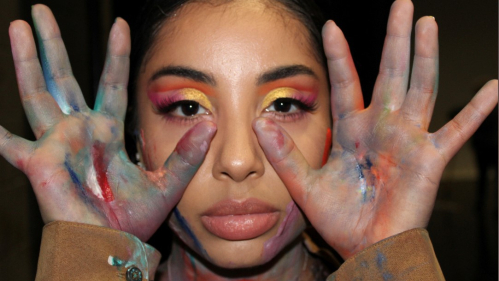The virtual BFA Senior Solo Concert challenged students to step offstage and explore dance on film
Like performing artists around the world, the students and faculty of Rutgers University’s Mason Gross School of the Arts have had to contend with a pandemic that closed Broadway and canceled performances on an unprecedented scale.
And like those other artists, Mason Gross students have responded with grit and inventiveness. The pandemic threatened to cancel the BFA Senior Solo Concert, an eagerly anticipated annual event in which senior choreography students collaborate with student composers from the school’s music department for live performances normally held at the Douglass campus’ Loree Dance Studio Theater.
This year, dance professors Ani Javian and John Evans were forced to turn the solo concert into a virtual event, much to the initial disappointment of students who had been looking forward to it for years. But the students soon embraced the challenges of going virtual and launched into a robust collaboration. All five Mason Gross departments participated to make the concerts happen: Art and Design, Dance, Filmmaking, Music and Theater.
“Our whole field had questions about how to continue making work during a pandemic, but these students are showing us how,” Javian said. “Because performing their solo pieces on the stage isn’t an option, they’ve gone elsewhere, scouting sites, finding collaborators from inside and outside Mason Gross, looking through the camera and editing film for the first time, and doing all of this collaboration while following university rules for social distancing and testing.”
The virtual BFA Senior Solo Concert will display 22 student dance films over two hour-long events, each beginning at 7:30 p.m., on Nov. 16 and 17. The videos will be available for public viewing only during the events. Advance registration is available here.
Below are trailers submitted by some of the students. The videos are in their final stages of production and may ultimately differ from these previews.
Julia Foti
Julia Foti teamed up with Mason Gross digital filmmaking student Margot Maxwell and theater lighting design student Isaac Tremblay Anderson for a video that uses the influences of Chinese art to explore the cultural constraints and expectations placed on Chinese Americans and women.
“For the music, we used the score from a Chinese film and rearranged it, edited it, Frankensteined it together so it won’t necessarily be recognizable. We used a Chinese painting projected onto the back wall of a theater and filmed outdoors in a bamboo forest,” Foti said. “My collaborators and I had to learn to be flexible, to pivot and change our ideas, question ourselves and expand. For a strong exclamation point in the piece, we wanted to shoot outside with colored smoke—but we knew we would have to be flexible and make decisions quickly with the reality of that and with what happens with the wind and sparks. It was a fun learning process.”
Jessica Michal
Jessica Michal collaborated with Mason Gross digital filmmaking students Miguel Salcedo and Margaux Beck, and with Mason Gross music alumnus Nathan Bishop, a composer, and digital filmmaking alumnus Stephanie Bradli who provided an animated sequence. Michal’s dance video pays homage to her maternal grandmother.
“She passed away last year at 92, a strong Jewish woman, and so much of her legacy lives through me,” Michal said. “For a dance film, you’re choreographing in a different way, considering the camera angles and shooting locations. I went full force with this. The process taught me to think logistically about communicating and building professional relationships with my collaborators. We had multiple Zoom calls leading up to shoot day and filming. We have a Facebook group where I’m posting my choreography, music inspiration, discussing angles and shots. I wasn’t just a dancer and choreographer but a manager because we had a pretty big team,” Michal said.
Sarah Liebau
Sarah Liebau worked with Mason Gross digital filmmaking student Tamara Tinawi and electronic musician Nathaniel Johnston, a student of English and geography at Rutgers-New Brunswick’s School of Arts and Sciences, on a video that explores the expectations of femininity that are imposed on girls and women and the experience of learning to build a more genuine identity of femininity and womanhood.
“This process has reminded me of the importance of making art that is satisfying for yourself. The performance of it won’t be what we originally expected. It won’t be in a room with a live audience; there won’t be an after-performance where people will come up and interact. So there’s an importance in making this for yourself, not outside validation. Especially in a time like now, it’s important to make something that is satisfying for yourself,” Liebau said.
Cassidy Rivas
Cassidy Rivas worked with friends in her hometown of Brooklyn, NY, to create a video that embodies the melting pot of New York City as a fusion of disparate choreographic and musical styles along with bright splashes of paint on her face, hands and clothes, “a whirlwind of who I am as an artist.”
“This experience allowed me more room to try different things that I’d be limited from doing onstage. There was the challenge of collaborating in-depth with different artists along with time constraints, limited spaces, and COVID restrictions,” Rivas said. “I learned that it’s all a work in progress, all a learning experience. I learned to trust my gut and not doubt the process, given [that] it was one of my first projects of this kind. A quote I go by is: ‘The journey is far better than the reward.’ The outcome may not be perfect, but what I’ve gained is foundational to what I’ll do in the future.”



